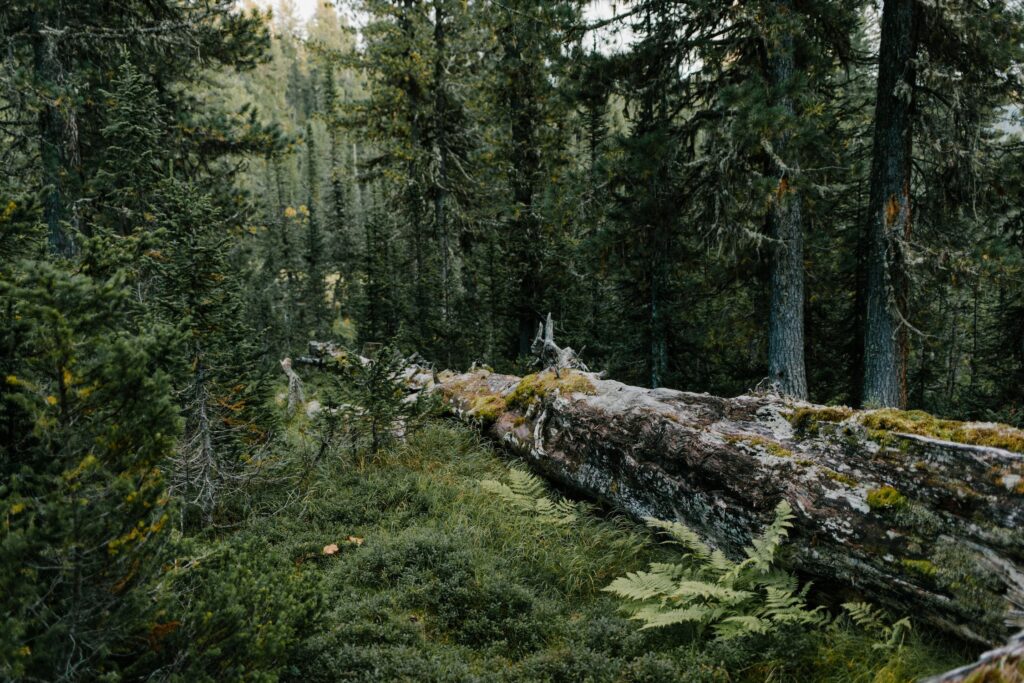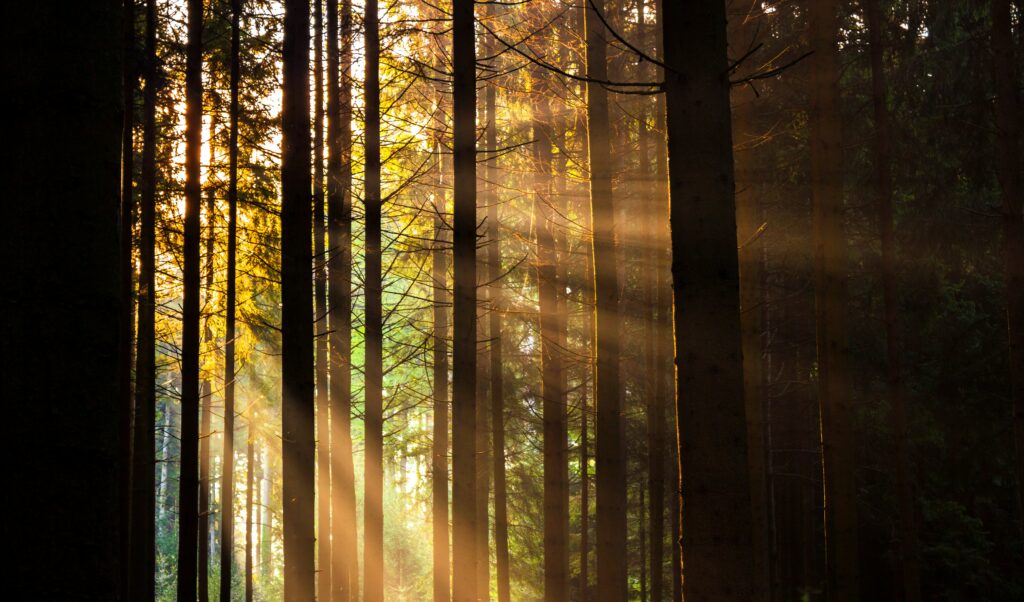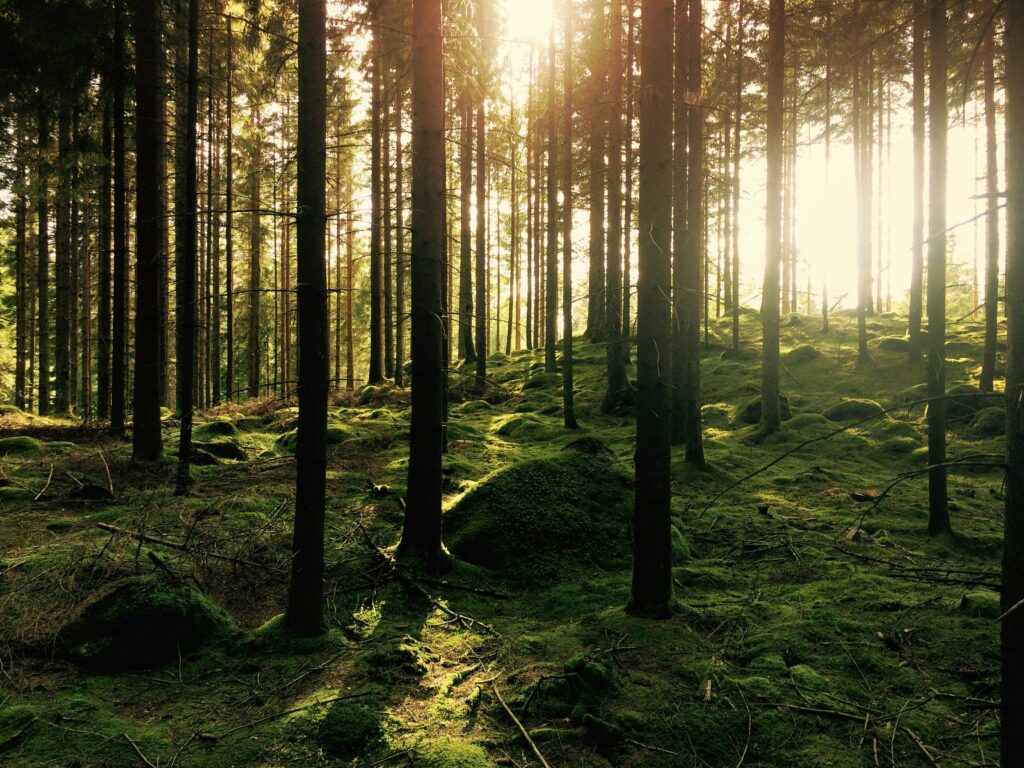PRODUCTION- AND NATURAL FOREST
A forest for the nature (crisis), a forest for the climate (crisis)

50% Natural Forest

50% Production Forest
The planet is heating up, species are disappearing, and populations are declining at an alarming rate. We humans are to blame for this.
Nature is being continuously degraded to serve our interests. With this development, we must take action in natural resource management if we are to avoid causing more damage than has already been done. We need to move toward a truly sustainable society and sustainable use of resources.
The forest has always provided us with the materials we need, and it will continue to do so. But now, we must also use the forest for carbon harvesting, something the planet and future generations depend on. At the same time, the forest must be preserved to protect biodiversity. How can we achieve these seemingly conflicting goals? Sylva has developed a unique forest management concept with a pragmatic and forward-looking approach. We manage forests to optimize both carbon capture and timber production, alongside protected forests that safeguard life for all time. This is Sylva’s concept of natural forest and production forest.
NATURAL FOREST
The Nature Crisis
The Nature Crisis requires us to secure habitats for species and conditions for rich biodiversity. That is why it is so important to protect natural forests over large enough areas to ensure our ecosystems do not collapse. In Norway, only 5.3% of all forests are protected. The national goal is 10%. Most forestry experts consider this far too little. Therefore, Sylva’s forest management concept will leave a significantly larger portion of the forest as untouched natural forest.
PRODUCTION FOREST
The Climate Crisis
The Climate Crisis requires increased use of biomass for materials (which is the most climate-friendly material), as well as using the forest for carbon capture and storage. In Sylva’s forest management concept, the part of the forest managed as production forest can be optimized 100% for maximum biomass production without needing to consider biodiversity (because biodiversity is protected in the natural forest). It is from the production forest that Woodstore harvests surplus biomass. By managing the production forest optimally, we believe we can multiply timber and biomass production several times over, thereby reducing the land area needed for production forest in favor of more natural forest.
What is wrong with today’s forest policy?
Opinions on how forests should be managed vary widely:
- Some believe that practically all forests should be protected to prevent the nature crisis
- Some believe that forests should be used to their fullest potential for biomass production
- Some believe we should stop clear-cutting and switch to selective logging instead
- Some believe that clear-cutting is necessary to achieve optimal growth and profitability
The authorities have adopted a policy where about 10% of the forest is protected, while the rest is managed in a way that somewhat considers biodiversity within production forests.
Sylva believes that new ideas must be introduced into the forestry industry. While we cannot be certain that our ideas are the absolute best, we are 100% sure that today’s forestry management policies need to be scrapped.
DIFFERENCE BETWEEN NATURAL AND PRODUCTION FOREST
Carbon capture and preservation of biodiversity
The natural forest will consist of larger contiguous areas that should remain as undisturbed as possible to preserve the forest’s natural balance.
The production forest will act as a carbon sink and be managed for timber and biomass production. It will be optimized for CO₂ uptake through the use of fast-growing trees.
TO SOLVE THE NATURE CRISIS WE NEED
Natural Forest
WHAT IS A NATURAL FOREST?
A natural forest is a forest that has developed naturally with little or no human influence and has been allowed to grow freely over a long period of time.
Natural forests are often characterized by:
- High level of biodiversity: Natural forests often have a rich interaction between various species of plants, animals, fungi, and microorganisms.
- Different age classes of trees: Trees can be at different stages of their life cycle, including dead and dying trees, which provide important habitats.
- Natural dynamics: Processes such as windthrow, fires, diseases, and natural regeneration drive the development of the forest.
WHY NATURAL FOREST?
Norwegian forests are home to 22,000 different plant and animal species, which make up about two-thirds of all species in Norway.
It is a system that has been balanced for thousands of years, but it is fragile. The impact on a single species can have consequences for the entire ecosystem. Today, we know that the way we manage forestry changes the composition of species.
Establishing natural forests will help ensure the survival of species and protect our natural heritage, while preventing human impact from disrupting the ecosystem.
- Natural forests are genetic reservoirs: Many species from untouched areas may find uses in the future through new discoveries.
- Natural forest contains rare and endangered plant and animal species: Natural forests are rich in plant and animal species. Many of these species are rare because they depend on the conditions found only in untouched forests.
- Natural forests provide valuable nature experiences: Natural forests offer unique nature experiences, allowing people to see the forest as it has always been.
DID YOU KNOW...
Did you know that one million animal and plant species are threatened with extinction...
Did you know that one million animal and plant species are threatened with extinction, and since 1970 monitored populations have declined by over 70%? If we don’t reverse this trend, it could have potentially catastrophic consequences.
HOW?
Mapping the forest to identify the special and important habitats is essential...
Sylva will collaborate with experts and professionals to identify areas suitable for natural forest. The natural forest will make up about half of the forest areas managed by Sylva. Mapping the forest to find special and important habitats is crucial, and forest areas with challenging and vulnerable terrain (such as wind exposure and landslides) will be prioritized as natural forest. One of the most important measures in the natural forest is ensuring that larger areas of untouched forest are connected.
DID YOU KNOW...
In a healthy natural forest, about one third of the forest consists of dead wood. Dead and old trees alone provide habitats for several thousand species, especially fungi and insects. Today’s managed forests contain only around 20 percent of the amount of dead wood found in well-preserved natural forests.
DID YOU KNOW...
Forest that has not been affected by human activity is defined as primeval forest. Less than 1% of the forest in Norway is primeval forest.
TO SOLVE THE CLIMATE CRISIS WE NEED
Production Forest
WHAT IS A PRODUCTION FOREST?
Production forest is forest managed with the sole purpose of maximizing biomass production.
Production forest is a term Sylva uses to describe forest managed optimally for the climate crisis in two ways: 1) it produces the maximum amount of timber, and 2) it captures the maximum amount of CO₂. Combined with the Woodstore method, this type of forest becomes a highly effective nature-based solution for carbon capture and storage. Another term for this kind of forest is “tree plantation.” With large enough areas set aside as natural forest, Sylva believes that the climate forest can be managed without prioritizing biodiversity beyond what is necessary for biomass production in the production forest alone. Biodiversity in a production forest is generally very limited. In Sylva’s concept, about half of the forest areas they manage will be production forest.
WHY PRODUCTION FOREST?
Sylva believes we can more than double biomass production in forests compared to typical current forestry practices. This will bring the following benefits:
- Increased timber production
- More carbon capture
- Larger areas of natural forest
- Increased profitability for forest owners
The increased profitability comes both from higher timber production but primarily from the opportunity to earn income through the sale of carbon credits. However, it requires more effort than current forestry practices. We believe this is more than compensated for by the earning potential.
DID YOU KNOW...
Did you know that in 2020, plantation forests made up only 3% of the world’s forest area, yet accounted for around 33% of the global commercial timber supply? Done right, plantation forests are highly efficient. With Sylva’s production forest concept, we believe we can increase that efficiency even further.
HOW?
Sylva’s production forests are typically managed like this:
1 | Harvest
The forest is clear-cut when it reaches its biologically optimal age. This is typically 20 to 25 years later than when forests are harvested today. The timber is delivered through “regular” channels or sold under our own climate product label.
2 | Harvesting of Residual Biomass (GROT)
Branches and treetops (GROT) are left on the harvested area for 6 to 12 months until the needles or leaves have naturally separated, as most of the nutrients are found in these parts. The GROT is then collected and chipped directly at the site, in the same way it is commonly done in Sweden and Finland, but still rarely practiced in Norway.
3 | Harvesting of Roots and Soil Preparation
In Sweden and Finland, it is relatively common to harvest roots and carry out soil preparation at the same time, while in Norway this practice is more controversial. The main argument against it is that it can cause increased greenhouse gas emissions and potentially harm soil health in the forest floor. However, when combined with the Woodstore method, the climate calculation is turned on its head, as the carbon in the roots is permanently stored in carbon chambers. In addition, soil preparation provides significant benefits for the growth of the new forest being planted.
4 | Deposition of Surplus Biomass
Branches, tops, and roots are shredded and stored in Woodstore carbon chambers.
5 | Planting of New Forest
Immediately after soil preparation, new forest is planted. In current forestry practices, replanting is often neglected. In many places, no replanting is done at all, and in others it happens several years after harvesting, where small spruce trees have to compete with fast-growing brushwood. Sylva will also experiment with the practical possibility of planting 50–80 cm tall pre-grown trees instead of the usual 10–15 cm seedlings. The advantages are that the production forest gains several years in the next growth cycle, and the battle against brushwood can be won without significant maintenance or thinning. In Sylva Forest, the small trees are grown under the power lines.
6 | Fertilization
Fertilizing forests has a huge positive impact on growth but is controversial due to negative effects like nitrogen runoff into waterways and fjords. Sylva aims to explore sustainable fertilization practices in production forests, including investigating the use of alternative types of fertilizers.
7 | Tending and Thinning
Profitability in today’s forestry is often so low that tending and thinning are not carried out. At Sylva, these practices will be implemented as cost-effective measures because the sale of carbon credits alongside timber sales makes such actions profitable.
